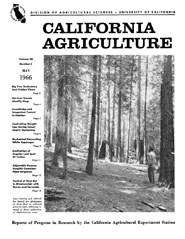


University of California
California Agriculture
|
|||
|
|||

Easy viewing and reduced fire hazard are advantages of clean floor in redwood grove to right, following removal of dense understory of shade-tolerant trees.
May 1966
Volume 20, Number 5 |
|||
|
University of California, 1301 S. 46th St., Bldg. 478 Richmond, CA
|